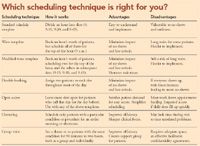Article
Smarter scheduling puts you in control
Author(s):
Weigh the pros and cons of four major scheduling strategies, and see what could work best for you.

Key Points

To be sure, the best-planned day can go haywire, thanks to no-shows, flu waves, road closures, and myriad other wild cards. "There is the ideal schedule, and then there is what actually happens," says pediatrician Eric Ruby in Taunton, MA.
However, when chaos becomes the rule rather than the exception, it's time to overhaul your approach to appointments. That means adopting scheduling techniques that will improve patient access while minimizing both lulls and backups throughout the day. Effective scheduling also requires an effective scheduler, somebody with the temperament, training, and judgment to keep things on track.
The most common appointment system is the most intuitive. Divide each hour into blocks of, say, 15 minutes, allotting one block for routine visits, perhaps two for new patients, and three for physicals. Then fill in the slots with patients.
This standard schedule has the virtue of simplicity, says Atlanta practice management expert Elizabeth Woodcock, author of Mastering Patient Flow and a consultant with the Medical Group Management Association. "Scheduling systems can be so complicated that they're hard to implement, and they can actually hurt productivity."
However, standard scheduling is vulnerable to disruptions. If a patient skips an appointment or shows up 20 minutes late, a slot goes to waste. If a visit lasts 15 minutes longer than planned, you fall behind.
Some doctors, such as proceduralists in affluent suburbs, have the punctual patients and predictable visits that make a standard schedule feasible. An inner-city pediatrician whose patients ride the bus, however, may not be as fortunate. Analyze your appointment patterns to determine whether this model is right for you.
Wave schedule: Eliminating downtime
To neutralize rampant no-shows and tardiness, doctors often turn to a wave schedule that front-loads patients at the top of every hour. Instead of booking patients for 9 a.m., 9:15, 9:30, and 9:45, you book all four at 9 a.m. Then, if one patient skips, you still have three patients ready to be seen. You can overbook the hour-in other words, schedule six patients for the four hypothetical slots-to keep you busy in the event of no-shows.
The glaring drawback of the wave schedule is that some patients who appear at 9 a.m. may wait up to an hour before they're seen. You can shorten wait times by making sure the 9 a.m. mix includes a quick procedure, such as suture removal, that you can perform while a new patient registers or has vitals taken. Still, long waits are a hallmark of this model. "It subordinates patient convenience to doctor convenience," says practice management consultant Judy Capko in Thousand Oaks, CA, author of Secrets of the Best-Run Practices. It should be the other way around, she says.





